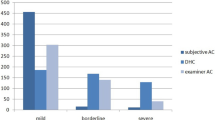Abstract
One of the territories of dental psychosomatics is the link between personality characterisctics and dental status. The aim of the present study was to survey the relationship between temperament and character factors and dental status in police students. It can be hypothesized, that some temperament factors can increase the risk for dental health problems. After dental screening 792 police students completed the Temperament and Character Inventory (TCI) devised by Cloninger. 57.5% of students rated their own teeth as being in good or very good condition, and only 2.8% as bad condition. In persons rating their dental status as “good”, the average DMFT was 9.23±5.01 (mean±S.D.). In students assessing their own oral health as bad, TCI results showed that a higher percentage of students displayed extravagance, impulsiveness, disorderliness than the overall population. Among the students with good self-assessment but bad teeth, there was a higher percentage of students displaying passivity, low assertiveness, and introversion. The temperament and character factors may have negative consequences for students in an institution which exposes them to high stress level. It may be useful to screen these students using subjective health questionnaires in order to permit more effective efforts to positive health behaviour.
Similar content being viewed by others
References
Genco R.J., Ho A.W., Grossi S.G., Dunford R.G., Tedesco L.A., Relationship of stress, distress and inadequate coping behaviors to periodontal disease, J Periodontol, 1999, 70, 711–723
Dumitrescu A.L., Psychological perspectives on the pathogenesis of periodontal disease, Rom J Intern Med, 2006, 44, 241–260
Emodi-Perlman A., Yoffe T., Rosenberg N., Eli I., Alter Z., Winocur E., Prevalence of psychologic, dental, and temporomandibular signs and symptoms among chronic eating disorders patients: a comparative control study, Orofac Pain 2008, 22, 201–208
Garcia-Pola Vallejo M.J., Martinez Díaz-Canel A.I., Garcia Martin J.M., González Garcia M., Risk factors for oral soft tissue lesions in an adult Spanish population, Community Dent Oral Epidemiol, 2002, 30, 277–285
Cinar A.B., Kosku N., Sandalli N., Murtomaa H., Individual and maternal determinants of self-reported dental health among Turkish school children aged 10–12 years, Community Dent Health, 2008, 25, 84–88
Monteiro da Silva A.M., Newman H.N., Oakley D.A., O’Leary R., Psychosocial factors, dental plaque levels and smoking in periodontitis patients, J. Clin Periodontol, 1998, 25, 517–523
Hobdell M.H., Oliveira E.R., Bautista R., Myburgh N.G., Lalloo R., Narendran S., Johnson N.W., Oral diseases and socio-economic status (SES), Brit Dent J, 2003, 194, 91–96
Sutton P.R., Psychosomatic dental disease: is mental stress in adults followed by acute dental caries in all racial groups? Med Hypotheses, 1993, 41, 279–281
Baranyai R., Bakos G., Steptoe A., Wardle J., Kopp M., Egyetemisták és főiskolások szívbetegséggel kapcsolatos egészségmagatartása, rizikótudata és hiedelmei. (Health behaviour, risk knowledge and beliefs among university and college students linked with hearth diseases.) Ment Pszichoszom, 2006, 7, 125–138
Cloninger C.R., Svrakic D.M., Przybeck T.R., A psychobiological model of temperament and character, Arch Gen Psychiatry, 1993, 50, 975–990
World Health Organization: Oral Health Surveys: Basic methods, WHO, Geneva 1997
Vass É.ZS., Milyen az újoncok foga 1995-ben?, (What is the dental condition in new recruits in 1995?) Fogorv Szle, 1997, 90, 267–272
Dawson A.S., Smales R.J., Dental health changes in an Australian Defence Force population, Aus Dent J, 1994, 39, 242–246
Suman M., Spalj S., Plancak D., Dukic W., Juric H., The influence of war on the oral health of professional soldiers, Int Dent J, 2008, 58, 71–74
Vered Y., Sgan-Cohen H.D., Self-perceived and clinically diagnosed dental and periodontal health status among young adults and their implications for epidemiological surveys, BMC Oral Health, 2003, 3, 1–6
Fábián T.K., Kelemen P., Fábián G., A Dental Anxiety Scale („Fogászati szorongás skála”) hazai bevezetése. Magyar populáción végzett fogászati szorongás epidemiológia vizsgálatok, (Introduction of the concept of Dental Anxiety Scale in Hungary. Epidemiologic studies on the Hungarian population.), Fogorv Szle, 1998, 91, 43–52
Cloninger C.R., Przybeck T.R., Svrakic D.M., Wetzel R.D., The temperament and character inventory (TCI): A guide to its development and use. Washington: St. Louis, MO: Center for Psychobiology of Personality, Washington University, 1994
Faragó I., Nagy G., Márton S., Túry F., Szabó E., Hopcraft M.S., Madléna M., Dental caries experience in Hungarian police student population, Caries Res 2012, 46, 95–101
Lencová E., Broukal Z., Dusková J., Psychosocial, behavioural and oral health indicators — review of the literature, Prague Med Rep, 2006, 107, 305–316
Sirpa A.V., Depressive symptoms in relation to oral health and related facors in a middle-aged population, Analytical approach, Acta Univ. Oul., Academic dissertation, University of Oulu, Oulu, Finland, 2003
Skec V., Macon J.S., Susac M., Jokic D., Rajdic D., Macon D., Influence of Oral Hygiene on Oral Health of Recruits and Professionals in the Croatian Army, Mil Med, 2006, 171, 1006–1009
Hopcraft M.S., Morgan M.V., Dental caries experience in a young adult military population, Aus Dent J, 2003, 48, 125–129
Muhvic-Urek M., Uhac I., Vuksic-Mihaljevic Z., Leovic D., Blecic N., Kovac Z., Oral health status in war veterans with post-traumatic stress disorder, J. Oral Rehabil, 2007, 34, 1–8
Author information
Authors and Affiliations
Corresponding author
About this article
Cite this article
Faragó, I., Túry, F., Márton, S. et al. Links between oral health and personality at a law enforcement school. cent.eur.j.med 9, 86–91 (2014). https://doi.org/10.2478/s11536-013-0251-9
Received:
Accepted:
Published:
Issue Date:
DOI: https://doi.org/10.2478/s11536-013-0251-9



